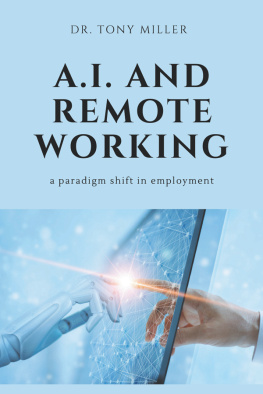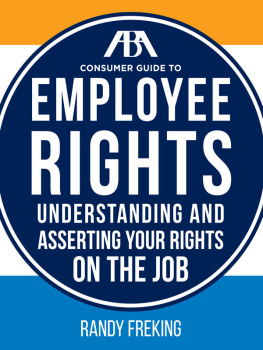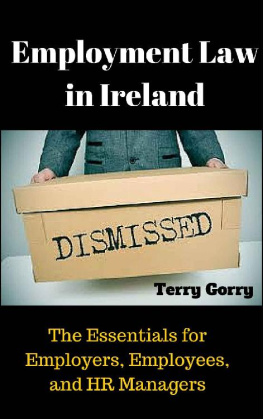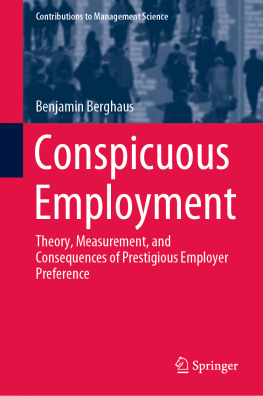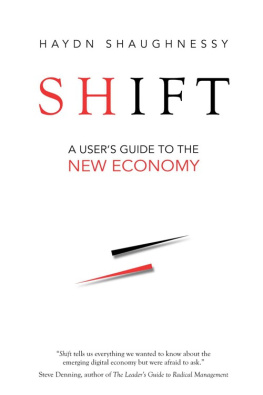A.I. and Remote Working
A.I. and Remote Working
A Paradigm Shift in Employment
Dr Tony Miller

A.I. and Remote Working: A Paradigm Shift in Employment
Copyright Business Expert Press, LLC, 2022.
Cover design by Charlene Kronstedt
Interior design by Exeter Premedia Services Private Ltd., Chennai, India
All rights reserved. No part of this publication may be reproduced, stored in a retrieval system, or transmitted in any form or by any meanselectronic, mechanical, photocopy, recording, or any other except for brief quotations, not to exceed 250 words, without the prior permission of the publisher.
First published in 2019 by
Business Expert Press, LLC
222 East 46th Street, New York, NY 10017
www.businessexpertpress.com
ISBN-13: 978-1-63742-121-5 (paperback)
ISBN-13: 978-1-63742-122-2 (e-book)
Business Expert Press Human Resource Management and Organizational Behavior Collection
Collection ISSN: 1946-5637 (print)
Collection ISSN: 1946-5645 (electronic)
Second Edition: 2022
10 9 8 7 6 5 4 3 2 1
Description
Artificial Intelligence (AI) will change the world as we know it within only a few years. Its most significant impact will be on our Human Resource (HR). What is AI and whats made it significant are contained in this concise book. The book has a wide readership and will provide for many organizations the catalyst for swift change to take strategic advantage of what AI has to offer.
In this book are some of the HR processes that can be changed today, suggestions on whats available, and some resources you may wish to use. The evidence so far is that many HR functions have not developed AI strategies, in a false belief that AI is in the future. But its here and its happening, and the change is expediential in its growth; we are in the change window for a massive paradigm shift, now is the time for immediate action.
The arrival of cognitive deep learning in AI will herald a massive paradigm shift in employment. The change is happening now. At the forefront of the change will be the human resource. This book is the catalyst for change many HR functions will need. Advice on progress with AI and specifically HR processes that will be most directly affected are contained within this concise book.
This is truly a golden opportunity for human resource professionals, organizational designers, business managers, business students, and workforce planners.
Organizations that act, and act fast, will be the beneficiaries of the AI and Homeworking revolution. The combination of A.I. and homeworking will be the biggest paradigm shift the world has ever seen on employment.
Keywords
algorithms; artificial intelligence; automation; bonus; change; change; cognitive learning; compensation; deep learning; Generation Z; human resources; iGen; organizational design (OD); paradigm shifts; poor performers; process re-engineering; recruitment; robots; talent; talented; unemployment; Universal Basic Income (UBI); workforce planning; homeworking; remote working
Contents
Historical Development
Unprecedented changes are happening in the world of work. What is of particular interest is, they are all happening at the same time.
We have the most significant advancement in artificial intelligence (AI) , which is now working, and it is beyond our full comprehension. What is staggeringthis has been happening dramatically since 2014. It is causing a massive paradigm shift that is irreversible, and it will change life and work, as we know it forever. To put this into context, if one looks at the development of humankind from 9000 BC to date, what we see in the past few years is expediential growth (Bauckhage 2017). The development of the gross world product has outstripped anything that has cumulatively happened beforeand it has happened dramatically fast.
Three predictions that were quoted by Bauckhage:
By 2027 every process will be managed by A.I. (Bauckhage 2017, University of Bonn, Germany)
By 2027 70% of all S&P companies will have disappeared. (McKinsey 2016)
60% of all professions will be affected by automation. (McKinsey 2016)

Figure 1.1 Significant development steps
If you do not have a strategy for AI already, you need to activate one now. Progress is moving so fast that organizations cannot afford to wait; changes will not waitfor sure.
AI has come to the fore because of three significant factors.
The first is what we refer to as Big Data. We now can manipulate vast quantities of stored data and with these data can produce predictive outcomes. Whats been in the press often is, how our digital footprint is now being used. From the moment you ever switched on a computer, mobile phone, or tablet or used a credit card, data have been recorded, stored, shuffled, packaged, and sold by companies such as Axiom. Big Data is now available to all.
The next is affordable high-powered computing. Processing speeds and storage have increased, and the prices of computing have dramatically dropped. We now have quantum computers, some of which allow free access.
The final is the emergence of deep learning systems. These are systems that start to learn by themselves using cognitive learningno need for old-style programming.
The formula then is
BD + HPC + DLS = AI.
You will hear the term neuro networks being used quite frequently these days; so, here is an attempt to explain what they are. In , here we have the straightforward mathematical computation an input, weighting and addition, then that gives us a mathematical output.
AI, particularly deep learning, develops things further and has made rapid strides in a relatively short span of time.
In AI, we connect many layers of neurons; in fact, today we have millions of these as paired inputs and likewise a multitude of outputs. Deep neural networks are vast and very complicated; the big breakthrough that happened recently is that these networks now have cognitive ability to process; this has caused a dramatic improvement and change. It can be called self-thinking. The program automatically alters the weighting and keeps self-adjusting until it achieves predetermined outcomes . The person credited for this is probably Geoffrey Hinton, the company who has been most instrumental in exploiting this GOOGLE.
To instruct AI and to get it to solve problems, we use algorithms. An algorithm is a detailed series of instructions for carrying out an operation or solving a problem. In a nontechnical context, we use algorithms in everyday tasks, such as a recipe to bake a cake or a do-it-yourself handbook.

Figure 1.2 A mathematical neuron

Figure 1.3 Deep neural network
AI system computers use algorithms to list the detailed instructions for carrying out an operation. For example, to compute an employees pay check, the computer uses an algorithm. To accomplish this task, appropriate data are entered into the system. What makes this particularly efficient is that, various algorithms can accomplish operations or problem solving easily and quickly.

